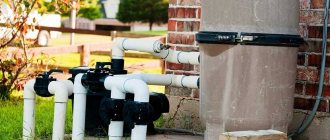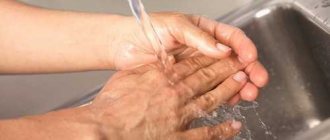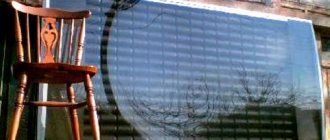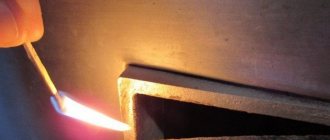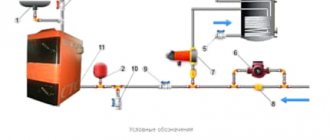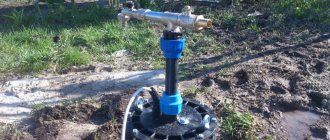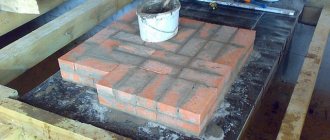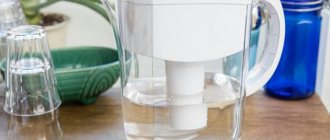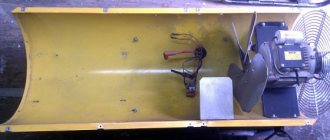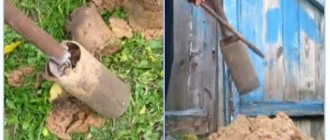Often, owners of private country houses are faced with the problem of drinking liquid contamination. These can be impurities of various types, including lime, rust, and salts. All this negatively affects human health and the functioning of vital organs. That is why it is worth paying special attention to how the source of autonomous water supply is arranged and installing filters for water from a well, primarily to remove sand, because this impurity is one of the most dangerous.
What is the danger?
Drinking liquid, according to sanitary standards, should not contain unnecessary components, just like technical liquid. A large number of sand particles, which in this case will be considered an abrasive, invariably lead to wear and tear on the equipment of pumping stations and household appliances.
| Liquid | Signs |
| Technical | The pressure velocity dropped sharply; liquid from the tap splashes in different directions; buzzing sound when the drink supply is turned on; Accumulation of sand particles at the bottom of dishes after washing |
Video description
Why you need to install a filter device in front of the meter is explained in detail in this video:
Attention! It should be taken into account that installing a filter will entail an increase in the length of the communication system.
Coupled filters are embedded in the pipeline, flanged filters are mounted on a flange. There are no difficulties with cartridge equipment; it is installed taking into account the instructions for the equipment.
How to clear sand from water
To minimize the level of pollution, it is necessary to take a certain set of measures. What does it include:
- Monitoring the condition of the casing during drilling operations.
- High-quality cleaning of new equipment.
- Avoiding long pauses in construction.
By following these tips, you can greatly reduce the risk of sand particles getting into the water, but you won’t be able to completely avoid it. In any case, effective cleaning will require high-quality equipment.
Functional purpose of the bottom filter
A bottom filter is a layer-by-layer embankment made of various natural materials that are not washed away by well water. Water passing through the filter is cleaned of debris, harmful impurities and suspended particles present in the well.
The installation of a bottom filter is mandatory in the following cases when:
- it is necessary to protect the bottom of the well from erosion;
- water flows under high pressure;
- at the bottom of the well there is fine or dusty sand;
- the well is opened by quicksand;
- protection of pumping equipment sensitive to clogging is necessary;
- the water level in the well is characterized by large differences, for example, during pump operation or precipitation;
- water quality is unsatisfactory: turbidity, sediment, unpleasant odor. You can read more about the causes of unsatisfactory water quality and how to eliminate them in this material.
Installing a bottom filter is not necessary if the well has exposed hard, fractured clay or rock formation. Do not use bottom protection if the water comes from natural springs. If the dense bottom of the well is not clogged with impurities and suspended particles, additional filtration is not necessary.
In other cases, to obtain high quality water, installing a bottom filter for a well is a mandatory step.
In most cases, wells require a bottom filter to purify the incoming water and improve its taste.
Types of filters for sand wells
There are many types of purification systems and devices that help capture solid particles and prevent them from entering the drinking liquid. First of all, they differ in their location, that is, the place of installation. There are types that are attached from below, inside or on the surface. Also, filtration systems can be divided by type of design and material of manufacture.
Grids
Mesh pipes made of stainless metal are an affordable, simple and understandable way to filter drinking water. If you choose the right model (it is important that the holes in the mesh are the right size for the grains of sand), then this device will be quite sufficient. It will serve you for a long time and will become a reliable assistant and protector of the entire water supply system. Another advantage of the device is that it can be easily changed if necessary.
However, when using this method, the pressure speed can be greatly reduced, since various impurities, including iron-containing ones, will quickly clog the mesh.
Holes and crevices
The system will work effectively in an inert environment; alone, in the absence of aggressive components such as large stones, pebbles, etc., it will begin to collapse over time. Large pieces of crushed stone will not pass through such filtration, but small particles will gradually clog narrow holes.
Wires
This subtype of flow filter for purifying water from sand is a pipe with slots. Many wires are attached to the frame, the distance between them is approximately 2 centimeters. Installation of such a system requires special technical training, but long-term operation is ensured.
Loading columns
In some situations, the power of the filtration cartridge may not be enough. In this case, backfill columns are used. Natural gravel serves as a filler here.
A flow from the source is supplied to the column from above, and the purified liquid is accordingly drained from below.
1.5 m3/h For process water
1.5 m3/h For process water
MBFT-75 Membrane for 75GPD
If there is a need to restore the activity of the filler, then use the backwash method.
Diatomaceous earth is often used as a filter material here. It is a kind of filter of natural origin. Settings with such a filler, due to the presence of many pores, purify drinking liquid from various harmful impurities. However, such a unit is quite bulky and takes up a lot of space, which can cause some inconvenience, which is nevertheless compensated by the extremely effective result.
Cartridges
These are models that are installed on the surface. They are presented in the form of cartridges with sieves made of polymer material, most often polypropylene. The cost is quite affordable, and if necessary, they can be easily replaced independently, without the help of specialists. They are also used to purify pool water.
Discs
The installation is almost completely identical to the previous one, but in this case it is made in the form of disk elements. It also contains polymers. Several such devices are installed in a purification installation, and impurities accumulate between them over time. Automatic models are considered the most convenient, unlike manual ones.
Membranes
Many filters for deep purification of sand from well water, which are classified as expensive, operate using the membrane filtration method.
Equipment based on reverse osmosis removes the purified liquid to a special zone, while contaminants fall into the drainage.
The operation of the design is based on the method of conventional filtration. Liquid passes through the porous material, and dirt remains on the surface.
To use this method, preliminary mechanical cleaning is necessary, otherwise the elements may be subject to rapid wear.
Autonomous water supply diagram
Before moving on to the topic of which water filter to choose for a summer house from a well, it is necessary to explain what an autonomous water supply network is. It consists of:
- a pump with which water is supplied from the well to the house ;
- piping;
- filter systems for water purification;
- sometimes a tank in which water is collected for storage .
In such a water supply system, two types of pumping equipment are used.
Superficial
They got their name only because they are installed on the surface of the well, without being lowered into the water. A hose or plastic pipe equipped with a mesh filter is lowered into the shaft. The latter is designed to hold large undissolved particles: pebbles, organic matter, garbage, sand, etc.
Surface pump for drawing water from a well Source eka-proffiks.ru
Since the water supply system is a system with constant off-season operation, it is necessary to create all the conditions for the pump to be located in an insulated space. There are several options for this:
- inside the well , where a platform is built from metal profiles , on which the pump is installed;
- carry out the installation of a caisson , inside which a pump , part of the piping and locking fittings are mounted;
- an insulated building is erected next to the hydraulic structure , which can be used additionally for domestic needs;
- install the pump inside the house : either in a specially designated utility room , or in the basement .
Scheme of an autonomous water supply system with installation of a surface pump in the basement of a house Source www.bigam.ru
Submersible
From the name it becomes clear that this modification of water pumps is partially or completely immersed in water. That is, it is located inside the well, and a pipe is already led from the device itself directly into the house. The design of the submersible pump already includes a strainer located on the suction pipe of the unit.
These are small pumps, compact, but with a sufficiently large power that can provide water to a small country house. As for the pressure, these devices cannot boast of a large indicator. That's why they are used to pump water from shallow depths (up to 10 m), which wells have.
Installing a submersible pump in a well Source stroyportal.ru
See also: Catalog of companies that specialize in water supply and sewerage.
Design features of coarse water filters to remove sand
By design, such devices consist of a body made of durable impermeable material with a mesh grille, as well as a special internal filler. Their main function is to retain large mechanical particles contained in drinking liquid.
Installation of cleaning devices of one type or another into the water supply system is carried out using a threaded or flanged method. Such devices are designed to clean and eliminate large solid particles of impurities, which lightens the load on all system elements.
Installation Features
To begin installing a water supply filter, you need to clean the surface of the pipeline and determine its tightness. To reduce the load on communications after installation of the equipment, it is additionally secured to the wall with a clamp.
If you install a filter for a water meter that has a seal, the filter device located in front of it must also be sealed. In this case, it is best to choose filters where there are eyes in the plug for threading the seal.
Both the meter and the filter need to be sealed Source klimatlab.com
During installation, it is imperative to seal the connections to avoid leaks.
DIY production and photo examples
In order to get an inexpensive and effective filter device, it is not necessary to buy it. It is quite possible to make it yourself using polymer and stainless steel pipes. It is important to take into account the fact that the lower part of any pipeline for installation deep in the well remains intact and serves as a sump.
Perforated version
Made from polymer pipe. Special holes are made in it: they can be of different shapes and sizes. The algorithm for creating this type of device is as follows:
SF-mix Clack up to 0.8 m3/h
SF-mix Runxin up to 0.8 m3/h
SF-mix manual up to 0.8 m3/h
- First, the workpiece is tightly fixed and secured in one place.
- Then, in a checkerboard pattern and taking into account the required specified size, marks are placed.
- Next, select the tool that best suits the width.
- Holes are cut at a distance of 2 to 7 cm.
- If necessary, mesh material is fixed on top along the entire length. This could be, for example, stainless steel with galloon weave. When choosing, you should pay special attention to the labeling. The numbers indicated will correspond to the sizes of the holes in the grille. Accordingly, the smaller they are, the smaller particles they can trap.
Wire
It is a type of mesh filter, but here the throughput system is made in the form of a wedge-shaped wire. Making such a device entirely on your own is quite problematic, since it requires special skills (for example, welding) and the process itself is labor-intensive and time-consuming. Therefore, it is best to buy a ready-made frame. This will make the process much easier.
The advantages of such a system include reliability and durability. Significant disadvantages include the high cost and complexity of manufacturing the structure.
What does the procedure for creating a device look like if you have a ready-made frame:
- The first is winding a pre-prepared pipe with wire.
- The second is welding the wire material to the frame in several places.
As a result, you get a completely fixed structure that is ready for installation in a well.
Gravel at the bottom
The gravel layer is a reliable means of protection against impurities in drinking liquid. The presence of gravel at the bottom acts as a shield, thereby eliminating the possibility of sand grains getting into your drink. Drainage from natural stones is prepared as follows:
- a deep hole is drilled with a reserve;
- a certain amount of gravel stones is poured into it;
- the casing is pumped, and then it is raised by about 15-30 centimeters and lowered.
This creates a barrier that prevents sand grains from entering.
Slot devices
Similar to slotted filter models, however, here the holes are replaced with slits. An algorithm by which you can make them yourself:
- Special slots are cut in the horizontal device. In this case, everything is divided into certain segments. Each subsequent cut through the block involves a 45° rotation. It is important to observe the chess order.
- The design is based on the principle of wire models. The gaps between the slots of vertical devices must be more than 10 mm.
- On the horizontal section of the pipe, perforated segments are formed at a distance of more than 20 mm.
Such devices are used for installation on unstable soils where the risk of rock collapse is high. The throughput of the model provides good performance, which is a definite advantage. However, there are also disadvantages: there is a high probability that the holes will become clogged with sand grains over time.
Mesh models
Devices with a slotted or perforated base on which a mesh is attached. There are various options, different in shape and cell size. However, holes can reduce the pressure due to obstruction, which consequently affects the performance efficiency of the system as a whole. The form is:
- standard models with square slots;
- multilayer keeper;
- complicated galloon options.
To make such a filtration device, you will need a blank - a slot filter. Using spot soldering, you will need to apply turns of wire to it.
Briefly about the main thing
The choice of a specific filter will depend on the purposes for which its installation is pursued. Most likely, there is no need to make the water completely drinkable. This is quite expensive and irrational.
Water used for the heating system and similar tasks should only be purified with a coarse filter. At the same time, for the kitchen it is worth choosing a multi-stage model, with which you can get high-quality drinking water.
Today there is a huge range of these devices on the market, so everyone can easily choose the optimal device for specific tasks. You need to install the filter in front of the meter; you need to invite a specialist for installation. After installing this device, you need to periodically clean it and, if necessary, replace it with a new one.
Reasons for sand getting into your drinking water
Construction of a new well is always associated with risk. There may be insoluble suspended matter in drinking liquid. During installation, they will easily end up in the source. What factors influence the release of sand granules into water:
AMETHYST - 02 M up to 2 cubic meters/day.
Aeration unit AS-1054 VO-90
Main table dispenser AquaPro 919H/RO (hot and cold water)
- Damage to the integrity of the backbone system. If there are leaks, especially at fastening points, solid particles from the soil can enter the main pipe.
- Damaged filter device. This could, for example, be a rupture of the mesh, which allows sand grains to enter the drink.
- Heavy rainfall and floods. If the mouth of the pipe is not closed tightly, this leads to rain and flood liquid entering the general main flow; the presence of sand impurities leads to its coloring yellow.
- Siltation (formation of sludge) with infrequent use.
General information
Filter systems are designed to retain small particles, thereby ensuring the primary purification of the incoming liquid from the water intake source. A coarse water filter for wells in autonomous water supply lines retains clay, grains of sand, and silt. With a central water supply, this kind of contamination does not penetrate into it, but in the process of transporting liquid through old water pipes, rust particles get into it. Moreover, the chemical composition does not change.
It is possible to maintain the normal operation of the filter only if it is periodically cleaned or new mesh equipment is installed. Cleaning devices without self-cleaning involves dismantling the mesh and washing it. Before unscrewing the mud trap, you need to close the access of water to the filter device.
When the mesh is cleaned, ensuring that there is no deformation on it, the device is assembled in the reverse order. Moreover, you need to pay attention to the condition of the silicone seals; if there are leaks in the connection area, they simply change.
Mesh filter devices have a simple design Source teplocity.com
Attention! Cartridge designs do not require cleaning; if they become clogged with dirt, the cartridge is simply replaced.
A coarse water filter is placed in front of the meter, washing machine and dishwasher; this helps reduce the likelihood of equipment failure due to incoming low-quality liquid and thereby extends the operating time of the devices.
So, among the main functions of filtering equipment it should be noted:
- protection of the pipeline from abrasive damage;
- retention of dirt particles dangerous to people;
- getting rid of unpleasant tastes and odors due to contaminated particles in water;
- protection of equipment from premature wear;
- prevention of pipeline clogging.
This equipment has different levels of cleaning, sizes, designs, but operates on the same principle - it allows water to pass through, creating a barrier to the passage of polluting particles.
A mud trap must be placed in front of the water meter Source moikolodets.ru
Features of installation and maintenance
One of the most common installation methods is the inlet version.
If the water supply system involves a complex configuration, then installation of individual segments is acceptable.
After the work is done, testing is carried out for possible leaks and errors. If there are any, they will be eliminated.
Conditions that must be observed for installation work:
- filtration equipment is installed in front of the meter - this will help avoid clogging;
- During installation, the sump must be directed downward;
- The direction of flow and the location of the filter element must match.
The frequency of preventive installation work is determined by the degree of contamination of the drinking liquid and the service life of the entire water treatment system.
Why and from what to filter water at the dacha
The water that accumulates in the well is not always suitable for human consumption or domestic use. Even if a dacha or country house is located far from the city, the groundwater sources feeding the well can be contaminated with industrial or organic waste or agricultural fertilizers.
The presence of impurities can be visually determined by the presence of sediment, which appears when the liquid settles for a long time. However, it may also contain impurities that are not visible to the human eye, but are extremely dangerous to health.
Today there are no completely pure groundwater layers: soil and rocks purify underground moisture only from mechanical impurities and some chemical elements, but are not able to rid it of bacteria, microorganisms, and nitrogen-containing substances. As laboratory tests of liquid from a well or borehole show, such water may contain:
- pathogens of various origins;
- impurities that increase water hardness;
- nitrogen compounds and hydrogen sulfide;
- toxic substances;
- salts of heavy metals.
Which sand filter is better to install?
In order to choose the right design specifically for your case, it is necessary to analyze the quality of the drinking liquid (the presence of impurities and the content of various substances). This is the most reliable way to determine which device is best for you - according to your case. Having determined the level of impurity contamination, you can install equipment whose power will be sufficient to solve your problems. This will allow you not only not to overpay for an expensive device, but also not to make a mistake with your choice.
Water filter for sand in the country: which one to choose
The hole or mesh type devices mentioned above are best suited here. Small stones, gravel, clay, sand particles will be retained with their help at the very beginning of the fence.
Industrial version
The main difference between household devices and industrial devices is power. Industrial equipment is designed to process large quantities of water, but in its design and functional use it is not much different from conventional equipment. However, it all depends on the specific purposes of use. Sometimes there are more complex options than those used to purify drinking liquid on a household scale.
Cleaning steps
Water purification from a well takes place in several stages:
- Pre-cleaning. At this stage, coarse impurities - sand, dissolved clay, and other mechanical particles - are removed from the water raised from the well. This can be done in two ways: coarse filters or settling tanks. It is very undesirable to omit this stage: large particles quickly clog fine filters and can even break them.
- Removal of iron, magnesium and some other chemical impurities and gases.
- Softening is the removal of salts by ion exchange, in which the salts precipitate and their residues are removed at the next stage.
- Fine cleaning and disinfection. At this stage, biological purification from microorganisms and bacteria occurs. And fine filters filter out small particles.
- Drinking preparation. At this stage, filters that operate on the principle of reverse osmosis are usually installed. Only that part of the liquid that is used for cooking or drinking is driven through them.
Different drinking water standards
In each specific case, the number of purification stages is determined based on the analysis of water from the well. If the content of any substances exceeds the norm, methods for reducing their concentration and equipment for this are selected.
You can read about automatic watering systems here.
Types of main filters
A main filter will help solve the problem of cleaning well water. It is installed on pipes and becomes an element of the plumbing system. Such flow filters are produced separately for cold and hot water.
The main installation removes insoluble impurities of iron, calcium, magnesium, and organic compounds from water. Such filters may include several stages of cleaning. Single-stage models guarantee a minimum amount of impurity removal. When installing them, you should take into account the need to frequently replace cartridges.
Two-stage main filters first perform mechanical and then sorption purification of the liquid. Three-stage models, in addition to the listed functions, remove iron impurities and soften water.
Types of filter systems for a private home
To determine the appropriate type of cleaning device, the liquid should be analyzed for the presence of:
- Soleil;
- Gland;
- Bacteria.
Let's consider various filter options, technical characteristics, advantages, and disadvantages of each of them. Here are examples of popular models and their prices.
In what cases is a bottom one needed?
The bottom filter is suitable for use on loose clay soil with a high sand content, where the water quickly becomes cloudy. Otherwise, sand particles contained in the water will fill the filter meshes installed in the house, which will lead to overheating of the pumping equipment or breakdown.
Attention! On a dense clay bottom, installation of a bottom filter is not necessary. In such wells the water is clean because it flows through aquifers. This will only become an obstacle to filling the source.
The installation of a bottom cleaner is carried out at the stage of well construction. They create a shield from untreated oak, aspen, and maple boards. But experts do not recommend taking wood, since it very quickly begins to rot, becoming a hotbed for the development of bacteria.
It is better to use natural cleaners:
- River or quartz sand;
- Pebbles;
- Shungite;
- Gravel;
- Crushed stone;
- Porous concrete.
Laying is done in layers. The height depends on the depth of the well. Does not need frequent replacement and will last for many years. The cost depends on the selected mineral filler.
Approximate price for a three-layer filter with a volume of 60–65 kg:
- Shungite – from 5000 rubles;
- Quartz sand – from RUB 3,000;
- Small pebbles or crushed stone – from 2000 rubles.
A bottom filter is easy to make with your own hands, but it is important to understand that it only removes obvious pollutants from the liquid in the form of particles of sand and soil.
Reference. For high-quality water purification, it is recommended to combine the use of a bottom purifier with mechanical or other filters.
The best option is to install an additional complex filter. A popular Russian model is the three-stage Geyser-BIO filter. Purifies water from impurities of iron, manganese, lime, particles of heavy metals, salts. Reduces hardness and eliminates odor. The average market price is 7900 rubles.
Mechanical
Remove particles that are not dissolved in water.
There are 2 types of cleaning:
- Thin. A polymer material is wound onto the cartridges, which allows particles smaller than 5 microns to pass through. The cost of filters ranges from 200 to 1000 rubles.
- Rude. It is a mesh that traps elements measuring 5–50 microns. A budget option, but ineffective. Need frequent washing. When clogged, the water pressure decreases. Price from 100 to 500 rubles.
Modernized models of mechanical filters are produced by the Russian company.
One of them is CEPEX DF – disc wash filter. Has a large dirt holding capacity. During operation, the discs are compressed, leaving a dense mesh structure where particles of sand, soil, and clay are retained. Does not need to be replaced, but will have to be removed and washed periodically.
Disc wash filter CEPEX DF
Average price – 700 rubles. A model of a mechanical filter with automatic washing from the company will cost from 13,000 rubles.
Reference. The main purpose of mechanical filters is to protect and extend the service life of household appliances. To consume water for food, it is recommended to use additional sorption or osmotic purifiers.
Sorptive
They remove particles of heavy metals, chlorine and bacteria from water. Eliminates unpleasant odor. They make water clear and drinkable raw. Often this is a jug-shaped container with a cartridge inserted inside. The basis of the cartridge is a sorbent. The most popular is activated carbon, but may vary depending on the manufacturer.
Sorption filters are in great demand among summer residents because they are inexpensive and easy to transport . The container is filled with unpurified water and after a few minutes it can be consumed.
Filter jug BWT Penguin 2.7
According to consumers, the leader of this series of filters is considered to be the imported BWT Penguin 2.7. Copes well with heavy metals and chlorine. Convenient to wash and use. No deficiencies found. Price – 1300 rub.
More budget-friendly products from domestic companies are the Aquaphor Line jug filters (350 rubles) and Barrier Smart (600 rubles), but they cannot cope with heavy metals. Will have to wash frequently. Reviews of the Line and Smart models are available via the links.
Trunk
They have a wide range of applications, both in agriculture, industry, and in a private home or country house. They are attached to water mains, thereby preventing harmful substances from entering domestic water.
Classified by degree of purification:
- Single stage. Remove obvious impurities that are not dissolved in water. They clog quickly, so you will have to change them often.
- Two-stage. More reliable. In addition to mechanical cleaning, they also include sorption purification.
- Three-stage. They combine the functions of the first two types. In addition, they remove iron. Reduces water hardness. The highest quality filter option.
Cartridges are:
- With braided propylene;
- Winding;
- Mesh.
Main filters are used for both hot and cold water.
Based on the results of last year, Geyser Typhoon 20 BB, which has the highest degree of purification, is considered the best in this series of filters. Average price – 13,000 rubles.
Filter Geyser Typhoon 20 BB
AquaShield is considered an equally unique main filter. There is a powerful magnet inside that holds and breaks down salts. Moreover, the filter breaks down old scale, a deposit previously formed on the walls of the pipes. Excellent for hot water too. Price – about 5000 rubles. With a larger diameter, the cost will be correspondingly higher.
Geyser's direct competitor is the Aquaphor Viking main filter. Has a metal body with anti-corrosion coating. Purifies water from rust, sand particles, and pesticides. Eliminates unpleasant odor. Capable of purifying up to 25 liters of water per minute. Price – 8000 rub. Read reviews about the model on the Otzovik website.
Flow-through
Available in two types:
- Nozzles;
- Under the sink.
Their installation and operation require powerful pumps with high pressure in the system.
Let's look at each of them in more detail.
Faucet or hose attachments
Filters are attached to the tap or water supply hose. Provides a maximum of two-stage cleaning: mechanical, sorption.
Produced in 2 variations:
- Permanent. Attached to a faucet or hose. One nozzle can purify from 500 to 2000 liters of water.
- Removable. Dress as needed. To obtain purified drinking water.
Interesting! On average, one nozzle can produce from 0.2 to 6 liters of water in 1 minute.
A significant disadvantage of nozzles is the slowdown of the application system. Therefore, if the water supply comes from a deep well, it is not recommended to use nozzles. There is a high probability of overheating and rapid equipment breakdown.
Filter attachment – New Water T5
There are models on sale that do not interfere with the stable operation of the water supply system. Among them is the filter attachment – New Water T5. Suitable for hot, cold water. Cleanses away obvious contaminants. Yellow water, saturated with iron elements, makes it transparent. Has 3 degrees of purification. Price – 2700 rub.
A cheap option is the Barrier Comfort model. The filter attachment is removable type. If necessary, it can be easily screwed to the sink faucet or shower. Removes rust and reduces water hardness. But it slows down the deposition a little. Price – 1150 rub.
Under the sink
This type of filter does not threaten the operation of the pumping system, since it processes water very quickly. Has up to 4 degrees of purification.
The inside of the cartridge is filled with activated carbon. Thoroughly cleans the liquid from harmful impurities . But this advantage turns into a disadvantage after a while. A cartridge clogged with sand or silt becomes a breeding ground for the development of many bacteria. It is necessary to strictly monitor the timely replacement of the cartridge.
An excellent option is the product New Water Expert M312. Has 4 degrees of purification. The set includes a faucet for clean water. In addition to activated carbon, the cartridge contains silver ions, which provide maximum cleaning. The output water is close to bottled. Price – 5,947 rub. Read reviews about the model at the link.
New water Expert M312
For summer cottages where the water contains a high concentration of iron, a domestic filter - EXPERT Ferrum Barrier - is well suited. Eliminates unpleasant odor. Effectively copes with rust. Turns water from yellow to clear. Price – 3,790 rub.
Reverse osmacy
Another name is membrane filters. It is recommended to install in areas located near industrial enterprises and factories. Filters with a reverse osmosis system purify the liquid to a distilled state .
Important! The basis of the device is a membrane with many holes that allows only the smallest water molecules to pass through. This prevents heavy metals, salts, and bacteria from getting into your drink.
To prevent the membrane from becoming clogged quickly, experts advise installing additional filters with cartridges based on polypropylene or activated carbon. Due to this, water that has undergone several degrees of purification is supplied to the membrane device.
A significant disadvantage is the large volume of water transmission . To get 5 liters of purified water, the product processes 40 liters, that is, the main part is wasted. And in the private sector, where the sewage system is a cesspool, it will have to be pumped out much more often.
It is believed that reverse osmosis systems over-purify the water, which is why it turns out dead, devoid of any useful elements. But filter models are available for sale that can not only purify water by 99.9% of harmful impurities, but also saturate it with oxygen and beneficial minerals in safe quantities.
A striking example is the Atoll A-550 MAX filter. The volume of the clean water tank is 12 l. When boiling, scale does not form on the walls of the cookware. The only negative is that you will have to separately purchase a tap for clean water. Price – 16,700 rubles. Reviews can be found on the Yandex Market website.
Filter Atoll A-550 MAX
A competing model from another manufacturer is the New Water Expert Osmos MO530 filter.
Cleanses from:
- Petroleum products;
- Pesticides, herbicides;
- Chlorine;
- Organic compounds;
- Radioactive elements;
- Salts and heavy metals.
Eliminates odors. Reduces water hardness, due to which scale does not form when heated. The system operates almost silently. Price – 11970 rub.
Ion exchange
In other words - water softeners. The products are responsible for reducing hardness - the content of calcium, magnesium, and other alkaline earth metal salts in water. The state regulates the requirements for water hardness - SanPiN 2.1.4.1074-01. The norm is considered to be up to 7 mEq/l.
Hard water tastes bitter. When boiling it leaves a white coating on the walls. Constant use in food leads to the development of diseases of the gastrointestinal tract, joints and more.
The service life of household appliances, plumbing and heating systems is reduced. A filter based on ion exchange will solve this problem.
Water passes through the ion exchange resin, particles of calcium, magnesium, iron are retained in it, and in return the liquid is enriched with sodium ions.
It has a plastic or steel body, inside of which there is a capsule with resins. A significant advantage is the recovery of the ion exchange resin . You can do this at home by rinsing with a solution of kitchen salt.
More expensive models have multiprocessor control, so recovery occurs automatically.
The Cascade-Comfort-0.5 automatic model is considered an eternal ion exchange filter. Excellent for permanent use in the private sector. Produces from 0.5 cu. m of purified water per hour.
Ion exchange filter Cascade-Comfort
The guaranteed service life is 10 years . The cartridge does not require replacement. Cost – 78,000 rubles. Imported analogues will cost even more. For budget summer residents, such an expensive purchase is impractical. It is easier and cheaper to install a mechanical and sorption filter at the same time.
Reviews about the use of ion exchange filters can be read on the ForumHouse website.
Complex options
Does not need replacement. They work fully automatically.
Cleaned from the following impurities:
- Gland;
- Manganese;
- Ammonium;
- Heavy metals;
- Reduce stiffness;
- Organic compounds.
Consists of 3 main parts:
- Loading container. Material: high-strength plastic.
- Control valve. Installed on top of the cylinder. Fully regulates the cleaning process, restoring the filter if necessary. Has a built-in water meter. It is thanks to this element that human control over the device is excluded.
- Salt tank. Necessary for flushing the filter system.
Based on functionality, complex systems are divided into 3 classes:
- Standard. They purify water from organic compounds, metals, chlorine, and hydrogen sulfide. Eliminates odor and cloudy color. Reduces hardness. Budget model – Column EMS X starting at RUB 37,500.
- Premium In addition to the above functions, the systems are equipped with automatic control in Russian and protective heat-insulating linings. Example – ECOSOFT FK 1054 TWIN. Price – 103,000 rub.
- Elite. The systems are designed for areas with high water pollution. Works well with iron and petroleum products. This is the Ecomaster DOUBLET model from Ecodar, costing 118,000 rubles.
A complex filtration system is an expensive pleasure
A comprehensive filtration system is an expensive proposition . The purchase is only possible for owners of large country estates with an unlimited budget. For owners of dachas and small private sectors, you should pay attention to main-line, flow-through or mechanical filters in combination with a bottom cleaner.
Important! It should be remembered that the filter is selected strictly individually, based on the composition of the water and the required volume of liquid for cleaning.
Wall filter in a well
In the case when the flow of water entering the well is very weak, and filtration is also carried out through its walls, then installing a bottom filter is not advisable. In such a situation, the best option would be to install a wall filter.
To make a wall filter, it is necessary to cut V-shaped holes located horizontally in the lowest part of the well (the lower reinforced concrete ring), where filter elements made of coarse-cell concrete are installed.
Concrete for filters is prepared using medium-fraction gravel and cement grade M100-M200 without adding sand. The cement is diluted with water until the consistency of the mixture becomes creamy, after which pre-washed gravel is poured into it and mixed thoroughly. The resulting solution is filled into the cut holes and left until completely hardened.
The size of gravel for the solution must be selected taking into account local hydrogeological factors: the finer the sand fraction in the well, the smaller the size of the gravel
What is it and what is this water purifier used for?
This group includes all devices that purify water mechanically from large (from 10-15 microns) insoluble suspensions.
The latter include:
- sand;
- soil particles;
- rust;
- scale;
- seaweed.
Most often they are used as initial filters and installed at the entrance to houses or apartments, or directly in front of the protected equipment.
Installation of such devices is carried out for the purpose of:
- Mandatory protection of metering devices, modern water heating equipment and plumbing in apartments and houses connected to centralized mains (the worse the condition of the water supply, the higher the requirements for inlet filters).
- Primary purification of water taken from sand or silt wells, wells and open reservoirs, and sent to irrigation systems or private homes.
- Technical preparation of water before supply to heating, hot water and industrial equipment.
- Water preparation for fine purification systems.
Important! Such systems do not capture fine fractions and quickly soluble substances, but their use greatly facilitates the operation of other types of water filters.
